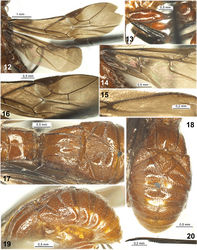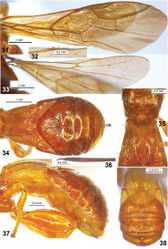Ivondrovia
| Notice: | This page is derived from the original publication listed below, whose author(s) should always be credited. Further contributors may edit and improve the content of this page and, consequently, need to be credited as well (see page history). Any assessment of factual correctness requires a careful review of the original article as well as of subsequent contributions.
If you are uncertain whether your planned contribution is correct or not, we suggest that you use the associated discussion page instead of editing the page directly. This page should be cited as follows (rationale):
Citation formats to copy and paste
BibTeX: @article{Belokobylskij2018ZooKeys, RIS/ Endnote: TY - JOUR Wikipedia/ Citizendium: <ref name="Belokobylskij2018ZooKeys">{{Citation See also the citation download page at the journal. |
Ordo: Hymenoptera
Familia: Braconidae
Name
Ivondrovia Shenefelt & Marsh, 1976 – Wikispecies link – Pensoft Profile
- Lophogaster Granger, 1949: 93.
- Ivondrovia Shenefelt & Marsh 1976: 1364; Belokobylskij 1992[1]: 912; Yu et al. 2012[2].
Type species
Lophogaster seyrigi Granger, 1949.
Description
Head (Figs 3–6, 22–25), not depressed, high, transverse. Ocelli arranged in slightly obtuse triangle. Frons slightly concave, with low double longitudinal carinae in anterior third (between ocellar sockets), slightly convex medially. Eyes glabrous. Occipital carina completely absent; occiput medio-dorsally with distinct, short, and divergent postero-laterally after short base hook (Fig. 4). Malar suture absent. Clypeus slightly convex, with distinct and rather long lower flange, almost entirely delineated from face by shallow or very shallow furrow. Hypoclypeal depression medium size and subrounded. Postgenal bridge very narrow. Maxillary palpus rather long (Fig. 2), 6-segmented, its sixth (apical) segment almost as long as fifth segment, third segments slightly widened and without projection in lower margin; labial palpus (Fig. 2) short, 4-segmented, its second segment slightly thickened, third segment not shortened, 0.8 times as long as fourth segment. Antennae weakly setiform. Scape of antenna (Figs 7, 26) wide and rather short, without apical lobe or basal constriction, with deep emargination in inner upper margin, its ventral margin (lateral view) not longer than dorsal margin. First flagellar segment sub-cylindrical, on outer side straight, almost as long as second segment.
Mesosoma (Figs 8, 9, 28, 29) not depressed. Neck of prothorax short. Pronotum dorsally weakly convex, its anterior flange short and curved upwards; pronope absent, pronotal carina distinct and slender, placed submedially on pronotum (dorsal view). Propleural dorsoposterior flange long and partly medially wide. Mesoscutum highly and convex-roundly elevated above pronotum. Median lobe of mesoscutum without median longitudinal furrow and anterolateral corners. Notauli deep and complete. Tegula (Fig. 27) distinctly widened distally, convex along outer margin. Prescutellar depression (scutellar sulcus) long and deep, with one high median carina. Scuto-scutellar suture distinct. Scutellum almost flat, with weak lateral carinae. Metanotum without median longitudinal carina. Sternaulus (precoxal sulcus) very shallow, narrow, long, straight, smooth. Prepectal carina distinct and complete, rather wide ventrally, prolonged laterally till upper margin of sternaulus. Postpectal carina absent. Metapleural flange long, wide, subtriangular, rounded apically. Propodeum with areas distinctly delineated by carinae, mainly smooth, with high sublateral carinae; lateral tubercles indistinct, propodeal bridge absent. Propodeal spiracles rather big and bean-shape. Metapleural suture very shallow.
Wings (Figs 12, 14–16, 31–33). Pterostigma of fore wing rather narrow. Radial vein (r) arising distinctly before middle of pterostigma. Radial (marginal) cell distinctly shortened. Both radiomedial veins (2RS and r-m) present. Second radiomedial (submarginal) cell medium length. First (r) and second (3RSa) radial abscissae forming an obtuse angle. Recurrent vein (1m-cu) slightly postfurcal or almost interstitial. Nervulus (1cu-a) postfurcal. Discoidal (first discal) cell petiolate anteriorly, petiole (1RS) not long and slightly thickened. Parallel vein (2CUb) arising from posterior 0.2 of apical margin of brachial (second subdiscal) cell. Brachial (second subdiscal) cell closed postero-apically by short, sclerotised and slightly inclivous brachial vein (2cu-a). Transverse anal veins (1a and 2a) absent. Hind wing with three hamuli (Fig. 32). First abscissa of costal vein (C+Sc+R) long, 0.8 times as long as second abscissa (SC+R); first abscissa (C+Sc+R) not divided apically on two branches. Radial vein (RS) arising from basal vein (1r-m) rather far from costal vein (SC+R). Radial (marginal) cell distinctly narrowed posteriorly, closed before apex of wing, without additional transverse vein (r). Medial (basal) cell not widened towards apex, subparallel-sided in apical half, 12.5 times longer than wide, 0.5 times as long as hind wing. Nervellus (cu-a) present, slightly sinuate. Submedial (subbasal) cell long. First abscissa of mediocubital vein (M+CU) 0.9–1.0 times as long as second abscissa (M) (till basal vein (1r-m)). Recurrent vein (m-cu) strongly antefurcal, very long, strongly curved in posterior 0.7 towards apex of wing, divergent apically with medial vein (2M).
Legs. Fore femur thick and short. Fore tibia with numerous short and thick spines arranged in wide vertical stripe (Figs 11, 30). Fore tarsus 1.5–1.6 times longer than fore tibia. Segments of middle tarsus short. Middle tibiae thick, with almost single line of thick spines. Hind coxa (Fig. 13) rather wide and short, without basoventral tooth and corner, dorsally without any processes or teeth, but distinctly convex. Fore and middle femora with low dorsal protuberances; hind femur without dorsal protuberance, thick. Hind tibia thick. Hind tibial spurs long, almost straight. Basitarsus of hind tarsus approx. half as long as second-fifth segments combined. Claws large, short, strongly curved, simple.
Metasoma (Figs 17–19, 34, 37, 38). First tergite sessile, short, and wide, strongly widened subbasally. Acrosternite of first segment short, 0.15 times as long as first tergite. Dorsope of first tergite small; basolateral lobes present, narrow and directed below; spiracular tubercles absent, spiracles situated in basal 0.3 of tergite; with distinct thick and slightly convergent posteriorly sub-lateral carinae and wide median carinae formed from two carinae curvedly fused in basal fifth of tergite. Second tergite with deep, wide, short, slightly divergent posteriorly and fused with second suture lateral furrows; these furrows and second suture medially define a large and leaf-shaped median area; additionally, second tergite in basal half with sub-triangular area and slightly separated by shallow or considerably shallow furrows. Second suture deep, rather wide, very strongly curved medially, sublaterally with very deep and sharp bends. Third tergite with shallow submedian transverse depression. Second-sixth tergites with separate laterotergites. Fourth-sixth tergites in their basal halves covered by rather sparse and long pale setae. Hypopygium medially on posterior margin with short and subpointed process. Ovipositor apically with two obtuse and weak dorsal nodes (Figs 20, 36). Ovipositor sheath longer than metasoma (Fig. 21).
Hosts
Unknown.
Distribution
Afrotropical Region.
Key to Ivondrovia speciesTaxon Treatment
- Belokobylskij, S; Zaldivar-Riveron, A; Castañeda-Osorio, R; 2018: Revision of the Afrotropical genus Ivondrovia Shenefelt & Marsh, 1976 with description of a new species (Hymenoptera: Braconidae: Doryctinae) ZooKeys, (747): 87-100. doi
Images
|
Other References
- ↑ Belokobylskij S (1992) On the classification and phylogeny of the braconid wasps of subfamilies Doryctinae and Exothecinae (Hymenoptera, Braconidae). Part I. On the classification, 1. Entomologicheskoe Obozrenie 71(4): 900–928. [in Russian]
- ↑ Yu D, van Achterberg C, Horstman K (2012) Taxapad 2012, Ichneumonoidea 2011. Database on flash-drive. Ottawa, Ontario.



